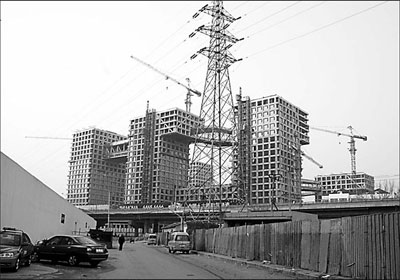Near the east of second rind road, adjacent to the embassy neighborhood and the Central Business District, an innovative new ecological residential community is rising in Beijing.
The Grand MOMA is among many striking new developments under construction in the capital city. Named by Time magazine as one of 2007's 10 architectural marvels - along with CCTV headquarters and the "Bird's Nest" Olympics Stadium - its eco-friendly approach has made it a showcase of innovation.
Designed by American architect Steve Holl, Grand MOMA features constant humidity and temperature for optimal comfort provided through much lower consumption of energy.
The complex is designed to use as much passive energy as possible. Without heating and air conditioning machinery, it uses a ground heat pump system for heating and cooling.
Beneath the floor of the underground parking lot, some six-hundred 100-meter-deep caissons filled with water provide the source for heating and cooling. Because temperatures underground are nearly constant year-round, water cycled under the earth absorbs or releases heat. After a heat exchange with soil, the buildings' indoor temperature is controlled by direct heating or cooling from ceiling radiators.
The complex's ceiling system replaces traditional radiators and air conditioners. As well, floor slabs are embedded with pipes carrying water from underground caissons that has been heated or cooled by the ground to maintain temperatures between 20 to 26 C, the most comfortable range for residents.
The MOMA design can produce three to four times more heating or cooling than traditional systems for each unit of energy used, says Chen Yin, vice-president of Modern Group, developer of Grand MOMA.
"The ground heat pump and ceiling radiation systems are not technically complicated and can be widely adopted in China," says Chen. "But they cost one or two times more than radiators and air conditioners to install. That's why they are yet rarely seen across China."
Houses and facilities at Grand MOMA will produce 482 tons of wastewater a day, 58 percent of which will be cooking and bathing water that will be treated using membrane biology technology.
After passing through bio-reactor and sterilizing devices, most wastewater will be reused in commercial outlets, the kindergarten, the theater and other buildings, with the rest used for watering grass and landscapes or refilling waterscape features.
To combat pollution, outside air is filtered to remove any particles, then sterilized, heated or cooled and humidified so that fresh air blows into every room.
To conserve heat, windows are equipped with double-paned glass filled with argon gas that also blocks ultraviolet sunrays.
Apartments at the development come already decorated and re-decoration is not permitted, says Chen. "That ensures the decoration is completely environmentally friendly and that the hi-tech system of the complex won't be damaged."
He adds that once completed, a property management company will take responsibility of the complex's maintenance and management. "The property management company is going to be in charge of energy saving in residents' daily lives," he says.
Green is less
Qiu Baoxing, vice-minister of the Ministry of Construction, says construction and operation of traditional buildings consume 50 percent of global energy and produce 34 percent of total pollution. Green architecture can reduce energy consumption by 70 to 75 percent.
|
Model of the Grand MOMA now under construction in Beijing. It is expected to be completed late this year. |
"But the green building concept hasn't been accepted by the public in China," says Chen. "Very few people bought our apartments for environmental reasons. They still put the location, design, quality and potential of increase in price ahead of environmental value."
Green buildings will take a long time before being fully embraced by the public, says Chen.
"Government officials, real estate developers and the media should join forces to promote this meaningful concept."
But it is already widely discussed topic and even a buzzword, so much so that developers were found using "green" as part of their promotional trickery.
As a result it has been defined by the Ministry of Construction through national criteria and detailed rules for implementation to protect both the environment and the rights of home buyers.
According to statistics, truly green architecture currently accounts for only about 1 percent of the total in China.
(China Daily January 29, 2008)







